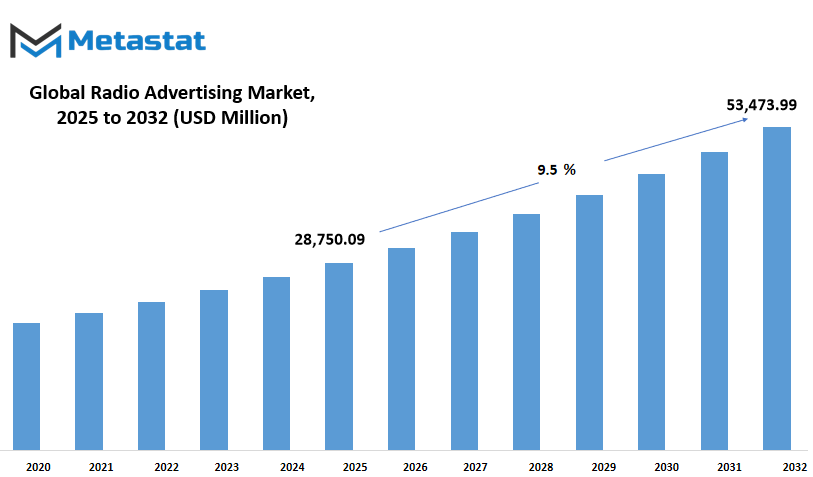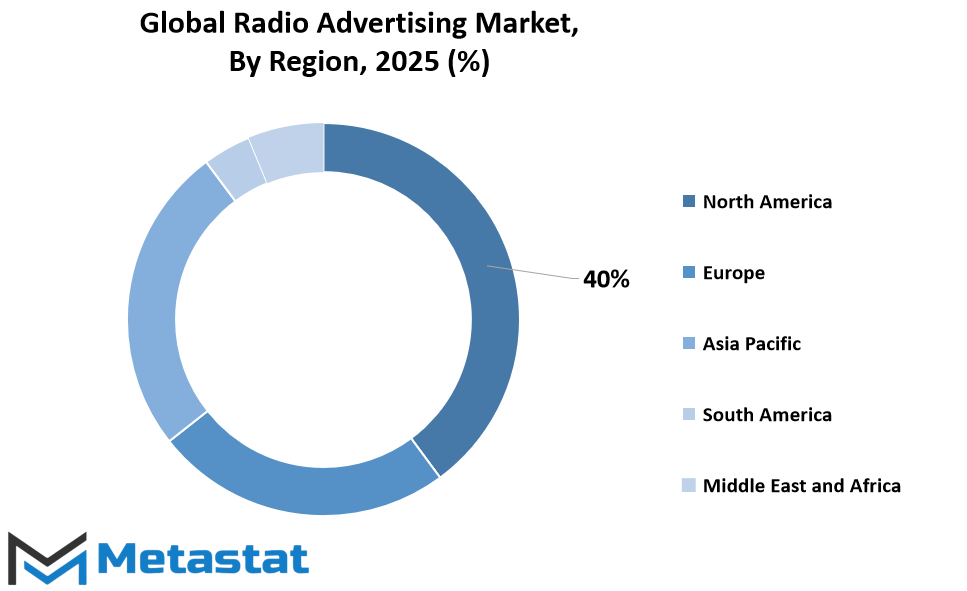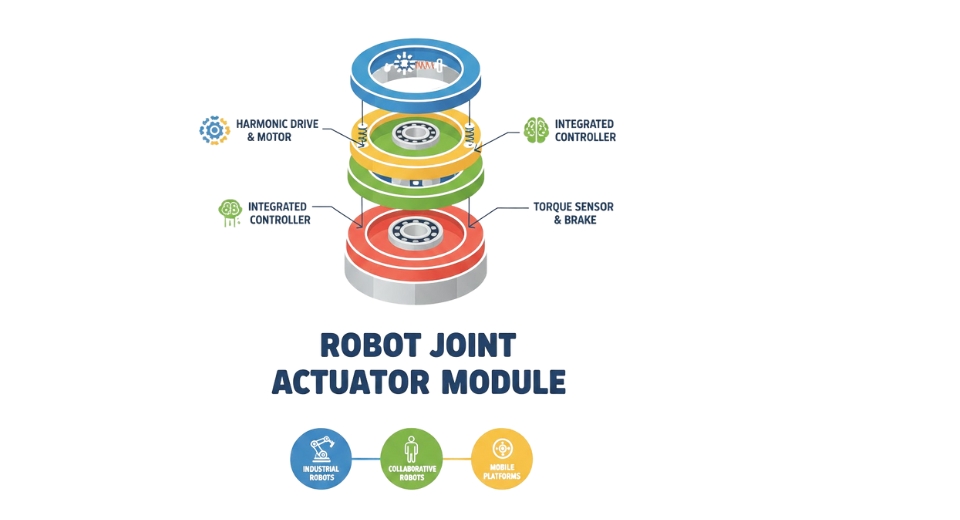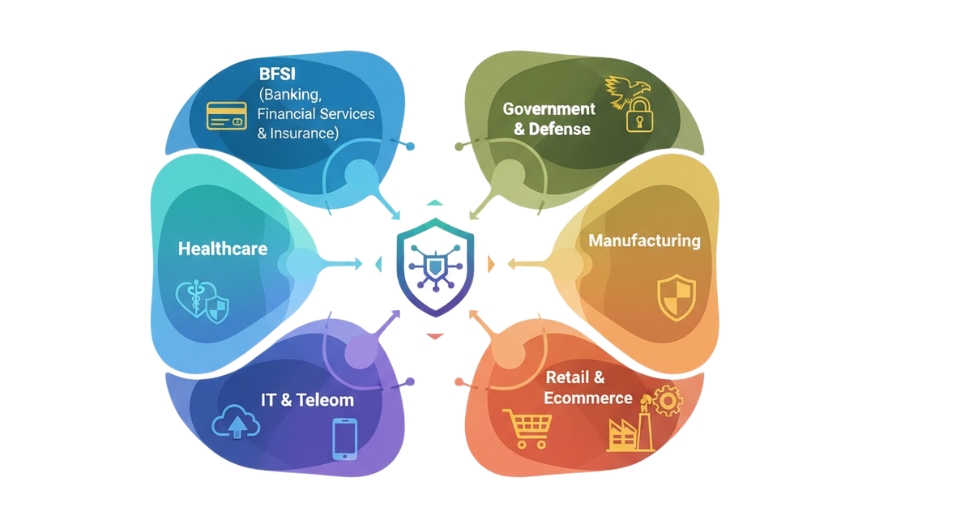MARKET OVERVIEW
The global radio advertising market is a niche business in the general advertising market because of the strong affinity between brands and consumers through the vehicle of radio. In spite of the lightning pace of development of digital media and the shift in patterns of consumer behavior, this market will find itself within a niche space in which audio-related communication intersects with marketing needs on a mass as well as local front. In contrast to user- and algorithm-tracking-based digital-first models, radio will continue to be strong in establishing trust in terms of affinity towards communities and cultural bonding.
The future global radio advertising market will no longer be characterized solely by its traditional formats, but also by its capacity to survive technology upgrades without sacrificing its inherent nature. Industry landscape will reach much further than traditional FM and AM frequencies, blending perfectly with digital streams of audio, podcasts, and on-demand channels of content. These connections will not replace the very essence of radio but broaden how advertisers connect with listeners who still listen to audio across their day.
At its core, this market works by embedding audio commercials into radio shows in premium spots. These placements will continue to shift between short commercial segments and long brand sponsorships woven into talk shows, news shows, and music blocks. But the size will expand as broadcasters and advertisers start to leverage data analytics to get more focused with their targeting without violating privacy like some digital content has been faulted for. This quiet transformation will influence how the global radio advertising market operates in unison with larger media plans.
The coverage of this marketplace does not limit itself to one geographic area, and its reach extends to urban and rural areas and all locales in between. The position of radio enables it to cover socio-economic domains while at the same time targeting mass audiences and special niches of listeners. In the coming years, such versatility will only intensify as non-European and non-North American markets fully exploit radio's penetrability in places where internet installation will be behind but radio waves will remain strong. It is not just the ability to reach the listener that makes the global radio advertising market different from the other advertising mediums but even the quality of contact that it provides.
People develop habits with certain shows, hosts, and stations that create a form of loyalty that would be hard to recreate for advertisers through visual or textual media. These social connections are the foundation on which radio will continue to be a desirable choice for those brands wishing to stay relevant to different audiences. Other than the present format, the future will witness this market adopting wiser technologies like AI-based programmatic ad buying, which will yield real-time messaging agility without losing the human touch. Measurement and attribution of audio content will also follow accordingly, offering improved advertiser insights into campaign success without loss of integrity radio is famous for.
In short, the global radio advertising market will go on to progress with technological advancements but remain linked to its heritage of promoting intimate connection between listeners and brands by means of sound. Its impact won't decline but discover new pathways expressing the evolving ways listeners globally live their lives.
Global radio advertising market is estimated to reach $53,473.99 Million by 2032; growing at a CAGR of 9.5% from 2025 to 2032.

GROWTH FACTORS
The global radio advertising market will continue to play a significant role in the future of advertising, especially because radio remains one of the most trusted and accessible mediums across the world. One of the major reasons for this is the strong presence of radio in rural and semi-urban areas where other forms of media, like television or high-speed internet, may not reach as effectively. This high level of penetration ensures that businesses, whether small or large, can tap into a wide audience through radio. Additionally, radio advertising is often seen as more affordable compared to television or digital advertising. For local and regional businesses operating on limited budgets, radio offers a practical way to spread their message without the heavy costs usually associated with other forms of media.
Looking ahead, the future of the global radio advertising market will likely be shaped by both challenges and new opportunities. One key challenge is the fact that radio lacks a visual element. For some products, especially those that rely on strong visual appeal, this can limit the overall impact of the advertisement. In today’s world, people are increasingly drawn to content they can see as well as hear, which puts traditional radio at a slight disadvantage. Moreover, a noticeable shift is taking place in how audiences consume audio content. With the rise of streaming services and digital audio platforms, fewer people, especially younger listeners, are tuning into traditional radio. This change in listener habits could potentially slow down the growth of the market if radio stations fail to adapt.
However, the global radio advertising market is not standing still. A significant opportunity lies in the integration of radio with digital technologies. For instance, the rise of programmatic advertising allows radio ads to be targeted more precisely to specific audiences, similar to how digital ads work. This not only increases the effectiveness of advertising campaigns but also makes it easier for businesses to measure their success. Furthermore, combining radio with online platforms can help maintain relevance among younger, tech-savvy listeners who prefer a mix of traditional and digital media.
In the coming years, the global radio advertising market will benefit from these advancements. While the challenges are real, the ability of radio to evolve and connect with digital tools ensures it will remain a valuable advertising medium. Companies that embrace these changes will find new ways to reach their audiences effectively, keeping radio advertising relevant well into the future.
MARKET SEGMENTATION
By Type
The global radio advertising market is expected to see steady changes in the years ahead as the industry continues to adapt to both technological progress and shifting consumer habits. Although many people today spend a large portion of their time on digital platforms, radio still holds a valuable place within advertising strategies. Traditional radio advertising has long been a trusted method for reaching wide audiences. It will likely continue to serve businesses looking to connect with local communities through familiar formats. Despite newer channels appearing, traditional radio will not fade away easily because of its strong presence and loyalty among certain listener groups.
On the other hand, terrestrial radio broadcast advertising is showing signs of adaptation as broadcasters aim to keep their audiences engaged in new ways. The ability of terrestrial stations to maintain relevance depends on how well they combine traditional content with digital platforms. This shift helps advertisers stay connected with their audiences across various listening habits. For example, more people now listen to radio through mobile apps or smart speakers, opening up extra opportunities for businesses to reach potential customers without relying solely on older equipment like standard radios.
Terrestrial radio online advertising represents a more modern approach within the global radio advertising market. With more people accessing radio content through the internet, advertisers are finding new methods to deliver their messages. This format allows more flexibility, targeting, and creative options that were not possible with earlier types of radio. It is likely this section will see growth, driven by trends toward personalization and digital convenience. This part of the market provides advertisers with useful data to measure how well their campaigns perform, something traditional methods could not always offer.
Satellite radio advertising adds another layer to the future outlook. While this sector may appear smaller compared to others, it serves a dedicated listener base that values content variety and fewer interruptions. Companies advertising through satellite radio often target specific groups who are willing to pay for quality programming. As this technology becomes more integrated with vehicles and home devices, it opens doors for future growth.
When looking at the numbers, traditional radio advertising is valued at USD 11,371.41 million, terrestrial broadcast advertising at USD 12,707.41 million, terrestrial radio online advertising at USD 3,492.87 million, and satellite radio advertising at USD 1,178.40 million. These figures suggest a stable foundation with room for innovation. Over time, the global radio advertising market will likely reflect both tradition and transformation, blending familiar strategies with newer, more adaptable ones to meet the needs of future advertisers and listeners alike.
By Enterprise Size
The global radio advertising market will continue to play a key role in how businesses connect with people, even as technology moves forward. While digital platforms grow fast, radio still holds a special place in daily life. People trust what they hear on the radio, and this trust is something companies will keep using to their advantage. Businesses of all sizes will continue to turn to radio to share their messages with wide and local audiences alike. Whether it is a small coffee shop or a large global brand, the need to reach people through trusted channels will not disappear anytime soon.
The market can be looked at by breaking it down into two main types of businesses: SMEs and Large Enterprises. Small and medium-sized enterprises, often working with tighter budgets, will find that radio offers an affordable way to reach their target customers. Radio lets them focus on local markets, which helps them build loyalty and recognition within their communities. This method of advertising allows smaller companies to compete with larger ones by giving them a voice in the places where their customers live and work. Over time, the flexibility of radio will allow these smaller businesses to adapt their messages based on listener feedback and changing customer needs.
Large enterprises, on the other hand, will continue to use radio on a much broader scale. These companies often have bigger advertising budgets and will use radio to strengthen their brand image on both national and global levels. For them, radio is not just about promoting a product but about staying present in the minds of millions. They will combine radio advertising with other forms of media, but they will not abandon it because it reaches people in places other forms of media cannot.
Looking ahead, the global radio advertising market will likely evolve through technology. Digital radio and streaming will bring more detailed data about listeners, helping both small and large businesses craft messages that are more personal and direct. Voice recognition and AI tools will change how ads are delivered, making them smarter and more engaging. Even with all this technology, the heart of radio will stay the same: it is a human voice reaching out, and that simple connection will keep the global radio advertising market strong for years to come.
|
Forecast Period |
2025-2032 |
|
Market Size in 2025 |
$28,750.09 million |
|
Market Size by 2032 |
$53,473.99 Million |
|
Growth Rate from 2025 to 2032 |
9.5% |
|
Base Year |
2024 |
|
Regions Covered |
North America, Europe, Asia-Pacific Green, South America, Middle East & Africa |
REGIONAL ANALYSIS
The global radio advertising market is expected to see steady changes in the future, driven by both technological improvements and shifts in consumer behavior. As companies continue to look for ways to connect with audiences on a more personal level, radio advertising remains an important tool. Despite the growth of digital platforms, radio still holds a strong place in the advertising strategies of many businesses. It offers a unique way to reach people during their daily activities, whether they are commuting, working, or relaxing at home. What makes this market even more interesting is how it varies depending on the region.
When looking at geography, the global radio advertising market is divided into several key regions, each with its own potential and challenges. North America, for example, includes the U.S., Canada, and Mexico. This area continues to show strong demand for radio advertising, particularly in the U.S., where local and national brands still rely heavily on this channel to promote their products and services. Canada and Mexico follow similar trends but with their own cultural and economic differences shaping the market.
In Europe, the market includes the UK, Germany, France, Italy, and the Rest of Europe. Countries like the UK and Germany have well-established radio networks that are trusted by listeners, making them valuable for advertisers. France and Italy also present steady opportunities as radio remains a common part of daily life. Across the region, brands are expected to continue exploring new ways to make their messages more engaging through radio.
Asia-Pacific is another major area, made up of India, China, Japan, South Korea, and the Rest of Asia-Pacific. This region holds a lot of potential for future growth due to its large populations and rising consumer spending. Radio in these countries continues to adapt alongside technological changes, and advertisers are likely to invest more as they aim to reach broader audiences in both urban and rural areas.
South America includes Brazil, Argentina, and the Rest of South America. Brazil leads the way with a vibrant radio culture, while Argentina also shows steady engagement with this medium. Radio remains a cost-effective choice in these markets, helping brands connect with a wide range of listeners.
Finally, the Middle East & Africa region is categorized into GCC Countries, Egypt, South Africa, and the Rest of Middle East & Africa. While these areas may face different economic situations, radio advertising is still used as a trusted way to share messages with the public. Over time, this market is likely to adjust as new technologies and consumer habits continue to shape how people listen to audio content.

COMPETITIVE PLAYERS
The global radio advertising market is expected to continue changing as technology and consumer habits evolve over time. Even though digital advertising has grown at a fast pace, radio still holds a special place for both listeners and advertisers. The global radio advertising market is driven by a unique ability to reach local audiences while also offering national and even international coverage. Many businesses still believe that radio offers strong engagement, especially because it fits naturally into daily routines like commuting, working, or relaxing at home. This connection helps brands create trust with their target audiences, making radio a reliable choice for advertisers.
Looking ahead, the global radio advertising market will likely see more innovation as traditional radio merges with digital platforms. The rise of smart speakers and apps has helped radio stations expand their reach beyond just car stereos or home radios. Advertisers now have more opportunities to create campaigns that blend traditional on-air spots with digital elements such as podcasts, live streams, and interactive content. This shift will allow advertisers to track listener behaviors more closely and adjust campaigns for better results. However, the core of radio advertising building brand awareness through sound and voice will continue to be its biggest strength.
Competition within the global radio advertising market remains strong, with several key players shaping its direction. Companies such as iHeartMedia, Inc, Sirius XM Holdings Inc, Audacy, Inc, and Cumulus Media Inc hold significant influence. These organizations are known for offering a mix of music, news, talk shows, and sports, which attract a wide variety of listeners. Additionally, Bauer Media Group, Global Media and Entertainment Ltd, and Alpha Media LLC contribute heavily to the market’s diversity. Each company brings its own approach to content and advertising solutions, helping brands reach specific demographics effectively.
Cox Media Group LLC, Townsquare Media, Inc, and Hale Advertising Limited are also important names that continue to play key roles in this space. Their efforts often focus on maintaining strong connections with local communities, which remains one of radio’s biggest advantages. Meanwhile, Katz Media Group, LLC, FILMYADS (Radio Mirchi), and Beasley Media Group, Inc are exploring new strategies to stay competitive, including partnerships and creative advertising packages. In the future, these companies will likely lead the way in adopting new technologies to keep radio advertising relevant and effective. While trends may shift, the global radio advertising market will remain a strong and adaptable platform for businesses looking to connect with audiences through sound.
Radio Advertising Market Key Segments:
By Type
- Traditional Radio Advertising
- Terrestrial Radio Broadcast Advertising
- Terrestrial Radio Online Advertising
- Satellite Radio Advertising
By Enterprise Size
- SMEs
- Large Enterprises
Key Global Radio Advertising Industry Players
- iHeartMedia, Inc
- Sirius XM Holdings Inc
- Audacy, Inc
- Cumulus Media Inc
- Bauer Media Group
- Global Media and Entertainment Ltd
- Alpha Media LLC
- Cox Media Group LLC
- Townsquare Media, Inc
- Hale Advertising Limited
- Katz Media Group, LLC
- FILMYADS (Radio Mirchi)
- Beasley Media Group, Inc
WHAT REPORT PROVIDES
- Full in-depth analysis of the parent Industry
- Important changes in market and its dynamics
- Segmentation details of the market
- Former, on-going, and projected market analysis in terms of volume and value
- Assessment of niche industry developments
- Market share analysis
- Key strategies of major players
- Emerging segments and regional growth potential








 US: +1 3023308252
US: +1 3023308252






